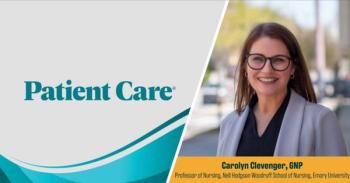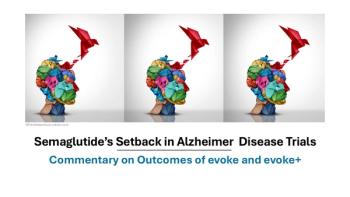
Likelihood of a Dementia Diagnosis Highly Influenced by Geography: New Research
Investigators found as much as a 2-fold difference in being diagnosed with dementia across the US, even after controlling for common individual risk factors.
The percentage of people diagnosed with Alzheimer disease varies significantly across regions of the US, with particularly marked differences among those aged 66 to 74 years and individuals who are Black or Hispanic, according to a new study from the University of Michigan.1 Investigators found that the likelihood of receiving a diagnosis of Alzheimer disease and related dementias (ADRD) varied by 2-fold based on place of residence.1
The association was consistent after multivariable adjustment for potential underlying individual risk factors, including education level, smoking rates, obesity, and diabetes, the authors reported.
“These findings go beyond demographic and population-level differences in risk and indicate that there are health system-level differences that could be targeted and remediated,” Julie Bynum, MD, a U-M Health geriatrician and lead author of the study, and colleagues said in a U-M Health statement.2 The research was published in Alzheimer's & Dementia: The Journal of the Alzheimer's Association.1
Bynum and colleagues analyzed data from 4.8 million Medicare beneficiaries aged 66 years and older in 2019 across 306 hospital referral regions (HRR), a geographic identification tool developed for the Dartmouth Atlas of Health Care and used routinely in research. A new diagnosis of ADRD was documented for 143,029 (3%) of participants during 2019 and ranged from 4% to as high as 14%, depending on geographic location of HRR.1 Those who were diagnosed wkth ADRD tended to be older vs those who were not diagnosed (82.7 vs 74.9 years, respectively) and were more likely to be women than men (61% vs 55.3%) but no other meaningful differences were observed.
The unadjusted HRR ADRD new diagnosis rate ranged from 1.7 to 5.4 diagnoses per 100 among older adults, for an unadjusted mean total rate of 6.8/100.1 Age category was a significant factor in the variation of diagnosis rate, the researchers reported. Based on their unadjusted analyses the research team found the disparity in new ADRD diagnosis rate across HRRs was greatest among the youngest group of older adults (ie, 23.2/100 among those aged 85 years and older and more than 10-fold lower [2.1/100] among adults aged 66 to 74 years) and among those who identified as Black/Hispanic vs those who identified as White/Other [6.5 vs 9.0/100]).
“These findings go beyond demographic and population-level differences in risk and indicate that there are health system-level differences that could be targeted and remediated.”
Using a measure of “diagnosis intensity” in each HRR (ie, observed to expected ratio of newly diagnosed cases), population age and sex explained the largest amount of variation in diagnoses (21%). The percentage of variation of new ADRD explained increased to 33% after accounting for race/ethnicity, education level, health status, and regional diagnosis intensity, the researchers found. Bynum and team could not explain the remaining variation.1
Using the national average for ADRD diagnosis as a benchmark, the researchers reported that individuals living in areas of lowest diagnosis intensity are 28% less likely to receive a diagnosis of Alzheimer disease or other type of dementia. In contrast, those in areas with the highest intensity are 36% more likely to be diagnosed.1 The implications for clinical practice and patient outcomes are significant, the authors point out. Although nearly 7 million Americans currently have a dementia diagnosis, many more likely have symptoms but remain undiagnosed. Without a formal diagnosis, access to advanced dementia treatments, including new medications and diagnostic tests, is virtually impossible, according to the U-M Health statement.2
The highest unadjusted concentration of ADRD cases was in the South, the lowest in the West/Northwest, according to the findings. However, after adjustment for the underlying sociodemographic and population dementia risk factors, the pattern shifted with the variation no longer following the expected “stroke belt” distribution, an observation Bynum et al said strengthened “the conclusion that the ADRD diagnosis intensity measure is not merely capturing underlying differences in population risk.”1
Bynum suggested that the variation could stem from differences in clinical practices, such as how frequently primary care physicians screen for dementia or the availability of specialists. It may also reflect individuals' knowledge and care-seeking behavior. “But the good news is, these are things we can act on once we know where to look,” she added.
Bynum suggested that the variation could stem from differences in clinical practices, such as how frequently primary care physicians screen for dementia or the availability of specialists. It may also reflect individuals' knowledge and care-seeking behavior. “But the good news is, these are things we can act on once we know where to look.”
The investigators note several limitations to the study including its observational design and limitation of the study population to Medicare fee-for-service beneficiaries, leaving open the potential for residual confounding and making generalizability of the findings beyond this group unadvisable, respectively. Diagnosis intensity was performed for only a small set of racial/ethnic minorities and, finally, no conclusions can be made on observed regional differences observed and differences in population health outcomes.
Limitations notwithstanding, Bynum et al are confident the study findings can help drive change at different levels of the health care system. “The goal these days should be to identify people with cognitive issues earlier, yet our data show the younger age group of Medicare participants (age 66-74 years) is the one with the most variation,” she said. Further, there was significant variation in the likelihood of an ADRD diagnosis for those who identified as Black or Hispanic, making a strong case for strategies focused on improved case-finding among these groups, wrote the team.1
“For communities and health systems, this should be a call to action for spreading knowledge and increasing efforts to make services available to people. And for individuals, the message is that you may need to advocate for yourself to get what you need, including cognitive checks,” Bynum concluded.2
References
1. Bynum JP, Benloucif S, Martindale J, O’Malley AJ, Davis MA. Regional variation in diagnostic intensity of dementia among older U.S. adults: An observational study. Alzheimers Dement. Published online August 16, 2024. doi:10.1002/alz.14092
2. Same person. Different place. Twice the odds of a dementia diagnosis. News release. Michigan Medicine. August 16, 2024. Accessed August 19, 2024. https://www.michiganmedicine.org/health-lab/same-person-different-place-twice-odds-dementia-diagnosis
Newsletter
Enhance your clinical practice with the Patient Care newsletter, offering the latest evidence-based guidelines, diagnostic insights, and treatment strategies for primary care physicians.

















































































































































































































































































